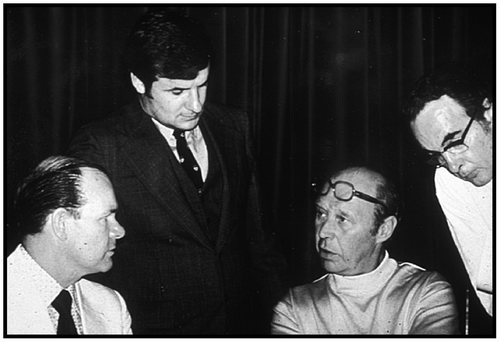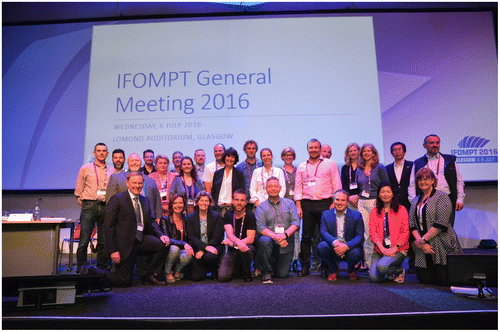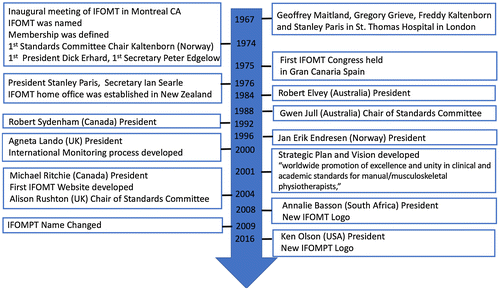Since its establishment, the International Federation of Orthopaedic Manipulative Physical Therapists (IFOMPT) has played a critical role in representing orthopaedic manual physical therapy (OMPT) internationally, encouraging evidence-based practice and the development and dissemination of scientific research. The purpose of this Editorial is to provide a window to the past to better understand the founders’ background and values and how that guides the role of IFOMPT in contemporary OMPT practice and patient care (Figure ).
Geoffrey Maitland, Gregory Grieve, Freddy Kaltenborn and Stanley Paris met in 1967 in the basement of St. Thomas Hospital in London and envisioned the International Federation of Orthopaedic Manipulative Therapists (IFOMT), the precursor to IFOMPT.[Citation1] While OMPT skills were practiced throughout the world, London proved to be an excellent central location for collaboration based on training provided to physical therapists by James Cyriax, James Mennell and Alan Stoddard [Citation2,3] throughout the mid-1900s.
In 1970, Stanley Paris organized a meeting at the World Confederation for Physical Therapy (WCPT) Congress in Amsterdam to form a committee to develop a new OMPT organization. The committee consisted of Paris (USA; formally New Zealand), Secretary, Hanna Thorsen (Denmark), Robin McKenzie (New Zealand), Kaltenborn (Norway), and Maitland (Australia), and were charged to form an international organization and meet at the 1974 WCPT Congress in Montreal, Canada. Committee members made contact with WCPT member groups and asked to identify a recognized person or organization to represent OMPT at the Congress.
Prior to the 1974 WCPT meeting, Kaltenborn convened a four-week meeting in the Gran Canary Islands, inviting 74 experienced physical therapists from 12 countries (including Australia, Canada, Denmark, Finland, the Netherlands, New Zealand, Norway, South Africa, Sweden, United Kingdom, and the USA) to review advanced techniques of mobilization and manipulation through lectures and demonstrations. Participants were assessed by recognized OMPT experts on their understanding of soft tissue and joint manipulation, and prescriptive exercise and proprioceptive neuromuscular facilitation during the final week of the meeting. These initial exams were a prototype for the first international OMPT examination.
The inaugural meeting of IFOMT was held in June 1974 in Montreal, Canada at the WCPT Congress that coincided with a joint meeting of the American Physical Therapy Association (APTA) and the Canadian Physiotherapy Association (CPA).[Citation4] The meeting was chaired by Paris with Kaltenborn, Maitland, and Grieve serving as consultants (Figure ). Nine countries were represented at that meeting with eight able to produce documentation that demonstrated they were an OMPT organization recognized by the WCPT member association. The eight countries with voting rights (later called Member Organizations ‘MO’) and the representatives were as follows: Australia-Joan Dwyer; Canada-John Oldham; Denmark-Hanna Thorsen; New Zealand-Ian Searle; Norway-Olaf Evjenth; South Africa-Frieda DeBruin; Sweden-Elsa Ingasson (per Kaltenborn); and United Kingdom-Gregory Grieve.
Figure 2. Formation of the International Federation of Orthopaedic Manipulative Therapists (IFOMT) 1974 Montreal, Canada (From left: Geoffrey Maitland, Stanley Paris, Freddy Kaltenborn, and Gregory Grieve.) From: In the Best Interests of the Patient Phys Ther. 2006;86(11):1541–1552. doi:10.2522/ptj.2006.mcmillan.lecture Phys Ther | © 2006 American Physical Therapy Association (With permission from Oxford University Press).

The USA was represented at this meeting by Dick Erhard, Sandy Burkhardt, Peter Edgelow, and Stanley Paris, who chaired the meeting. The USA was not approved as IFOMT voting Member Organization (MO) until the formation of the American Academy of Orthopaedic Manual Physical Therapists (AAOMPT) in 1991. The USA was voted in as a ‘provisional’ IFOMT MO in 1992 and remained such until 2004 when APTA President, Ben Massey, formally recognized the AAOMPT as the official organization representing the USA to IFOMPT.
Other items on the agenda of the inaugural meeting in 1974 were the naming of the organization and identifying its purpose. After much discussion, the organization was named IFOMT. Representatives from the USA and Canada were reluctant to use the term ‘manipulative’ in the organizational title, while others supported using the term as it would assist in international recognition of physical therapists as manual therapy specialists. The agreed upon purpose of IFOMT was to further the knowledge and standard of practice of manual therapy by physical therapists throughout the world.
Terms of IFOMT membership created some debate and it was decided that a country could only hold membership if the voting members of the association consisted of OMPT’s who had met the recognized IFOMT Educational Standards and were a subgroup of or recognized by the WCPT member organization from the same country. This requirement remains in the IFOMPT constitution.
The constitution was approved and a committee was formed to develop educational standards. The first Standards Committee consisted of Kaltenborn (Chair), Grieve (Co-Chair), Brian Edwards of Australia, and David Lamb of Canada. Richard Erhard was elected as the first President of IFOMT and Peter Edgelow, the first Secretary.
The first IFOMT Congress and General Meeting were held in Gran Canaria, Spain in 1975. An initial draft of the Standards Document (theoretical component) was developed and signed by the Standards Committee of Kaltenborn (Chair), Grieve, Lamb and, Edwards. Gwen Jull (Australia) became the Chair of the Standards Committee (then named membership committee) in 1988 [Citation5,6]. A new Standards Document was presented and ratified at the Vail, Colorado General Meeting in 1992. The Standards Document was subsequently reviewed in 2000 and ratified at the General Meeting in Perth, Australia. The Standards Document forms the foundation for assessment of the educational manual therapy programs that apply to become a MO.
In 1976, Paris and Ian Searle of New Zealand became President and Secretary, respectively. The IFOMT home office was established in New Zealand by Searle and has remained there since that time. The 1977 general meeting was held in Vail, Colorado, USA. The Standards Document (with theoretical and practical components) was ratified at the WCPT meeting in Tel Aviv in 1978. IFOMT was granted status as a subgroup of the WCPT in 1978 making IFOMT the first specialty subgroup of WCPT.
Subsequent IFOMT Presidents were: Robert Elvey (Australia) in 1984, Robert Sydenham (Canada) in 1992, Jan Erik Endresen (Norway) in 1996, Agneta Lando (UK) in 2000, Michael Ritchie (Canada) in 2004, Annalie Basson (South Africa) in 2008, and Kenneth Olson (USA) in 2016.
IFOMT met in 2001 in Antwerp, Belgium to create a strategic plan and developed the vision for ‘worldwide promotion of excellence and unity in clinical and academic standards for manual/musculoskeletal physiotherapists’, which has guided the organization for the past decade. The 2001 strategic plan identified the following priorities: funding, website development, education, communication and resource center. The first IFOMT website went live in 2004 and was updated in 2010 and again in 2014. A second strategic planning meeting was held in Cincinnati (USA) in 2013. Here, the main strategic priorities were branding, leadership, educational standards, communication, research, finance, and membership growth. The Executive Committee in 2016 established advisory workgroups to correspond with the strategic plan priorities to more actively engage the MO delegates in the work of IFOMPT.
The MOs of IFOMT voted to initiate an International Monitoring process at the General Meeting in Perth in 2000. This process, developed by Agneta Lando and Alison Rushton (UK), ensured on-going quality assessment of educational programs and achievement of the IFOMT Standards by MOs. The supplemental Standards Document Part B, International Monitoring Document was accepted at the General Meeting in Cape Town, 2004, where Rushton also became Chair of the Standards Committee. Additional Educational Standards Document revisions have been accepted at the General Meetings in Rotterdam, the Netherlands in 2008 and again in Glasgow, Scotland in 2016. The actual process of International Monitoring of individual MOs began in 2007, which has strengthened the educational programs and has led to reciprocal recognition by an increasing number of MOs that recognize OMPTs trained in other IFOMPT countries as fully credentialed members (i.e. Fellows) of their OMPT organizations.
A new IFOMT logo was accepted in Rotterdam at the 2008 General meeting. In 2009, IFOMT changed its name to incorporate the term ‘Physical Therapist’ to become IFOMPT. In 2015, as part of IFOMPT branding, the logo was revised again and accepted at the General Meeting in Glasgow 2016 along with the tagline, ‘The Global Leader in OMPT Excellence’.
IFOMT started out with eight ‘voting’ member countries and five ‘associate’ member countries. Currently, IFOMPT has grown to include 22 Member Organizations and 15 Registered Interest Groups http://www.ifompt.org/MEMBERSHIP+ORGANISATIONS+AND+RIGs.html. IFOMPT allows only one organization from each country to be MO. IFOMPT requires that all eligible educational programs that meet IFOMPT Standards within that country must be allowed to be active participants within the MO. This constitutional requirement has been met with resistance on several occasions, but in the end, has resulted in unification of the OMPT educational programs within many countries through formation of ‘umbrella’ organizations to represent all aspects of OMPT within a country. IFOMPT Presidents Elvey and Sydenham were instrumental in development of the ‘umbrella’ organization concept and countries such as the Netherlands, Germany, USA, and Greece have seen OMPT flourish within their countries after ‘umbrella’ organizations were formed. The non-voting category of membership called Registered Interest Group (RIG) are OMPT organizations that are working toward meeting the IFOMPT MO requirements. There can be more than one RIG from a particular country, but if both groups meet IFOMPT Educational Standards, they need to merge to become a MO.
Much of the recent growth and interest in IFOMPT has occurred in previously under-represented areas of the world including South America, Asia, Africa, and the Middle East. Four new RIGs have been accepted in the past year and up to six more are in development indicating that the future is bright for the growth of IFOMPT and OMPT worldwide. IFOMPT is an active and growing alliance of international OMPT organizations passionate about further development of OMPT throughout the world (Figure ).
Figure 3. IFOMPT Executive Committee Members and Delegates at the Congress in Glasgow, 2016 – Front row from left to right: Ken Olson (USA), Annelies Pool (the Netherlands), Laura Finucane (UK), Jeppe Thue Andersen (Denmark), Ragnar Faleij (Sweden), Nathan Hutting (the Netherlands), Nicola Mok (Hong Kong), Anita Gross (Canada); Back row from left to right: Steve White (New Zealand), Alexandros Sideris (Greece), Bob Rowe (USA), Davide Albertoni (Italy), Mindy Cairns (UK), Paolo Sanzo (Canada), Marike Kok (South Africa), Jouni Peltola (Finland), Niels Ruso (Austria), Marion Schreiner (Switzerland), Bart Vanthillo (Belgium), Renée de Ruijter (Switzerland), Bärbel Börgel (Germany), Ralf Schesser (Germany), Svein Kristiansen (Norway), Helen French (Ireland), Amy Fagan (Australia), Masao Yamauchi (Japan), Jose Miguel Tricas Moreno (Spain). Source: Author

As Lamb, Kaltenborn and Paris stated ‘IFOMPT must strive for proven levels of excellence and for each country to be very supportive of their own groups, and of other countries. We are a world-wide family’ who should be the epitome of excellence in manipulative therapy. This advice still holds true in 2017.
Bellarmine University, Louisville, KY, USA
[email protected]
Ken A. Olson
Northern Rehab Physical Therapy Specialists, DeKalb, IL, USA
International Federation of Orthopaedic Manipulative Physical Therapists
Jean-Michel Brismée
Texas Tech University Health Sciences Center, Lubbock, TX, USA
References
- Lamb D, Kaltenborn F, Paris S. History of IFOMT. J Man Manip Ther. 2003;11(2):73–76. doi:10.1179/106698103790826446.10.1179/106698103790826446
- Ottosson A. The manipulated history of manipulations of spines and joints? Rethinking orthopaedic medicine through the 19th century discourse of European mechanical medicine. Med Studies. 2011;3(2):83–116. doi:10.1007/s12376-011-0067-3.10.1007/s12376-011-0067-3
- Pettman E. A history of manipulative therapy. J Man Manip Ther. 2007;15(3):165–174.10.1179/106698107790819873
- IFOMT. Inaugural meeting minutes. 1974. Montreal Canada.
- IFOMPT Standards. A historical perspective 2011 [Internet]. Available from: http://www.ifompt.org/site/ifompt/files/pdf/XXIFOMPT%20Educ%20Standards%20%20%20IM%20Doc%20Merged.pdf
- Basson A, Rushton A, Olson K. History of IFOMPT [Internet]. Updated 2016. Available from: http://www.ifompt.org/About+IFOMPT/History.html

